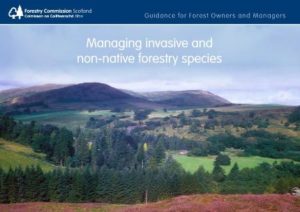FCS Guide for Managing Non-native Forestry Species
A guide for foresters on how to manage invasive and non-native forestry species has been published by Forestry Commission Scotland.
It aims to help forest owners and managers comply with their responsibilities to protect Scotland from any potentially damaging effects of invasive or non-native forestry species. These responsibilities are set out in the Wildlife & Natural Environment (Scotland) Act, the UK Forestry Standard and associated Biodiversity Guidelines.
Most non-native commercial tree species used in Scotland are exempt from the offences of the Wildlife & Natural Environment Act but they must still be managed according to the UK Forestry Standard.
However, under the Act, allowing any other non-native species to spread into the wild is an offence. In addition, special licences from Scottish Natural Heritage are required to release a non-native animals into the wild or to plant or regenerate a non-native tree or shrub that is not exempt under the Act.
The guide explains what is meant by wild and non-wild areas and takes the reader through the exemption Order and licensing system now in place. There is detailed advice on how forest plans should reflect these new responsibilities, and how to reduce the risk of invasive spread through forest planning and management.
For forest managers wanting to plant or regenerate a non-exempt species, there is guidance on how to fill in an application form for a non-native species licence and complete a risk assessment.






